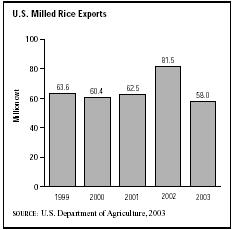SIC 2044
RICE MILLING
This industry comprises establishments that clean, polish, or process rice. Principal products include rice flour, rice meal, white rice, brown rice, and rice bran. The growing of rice is discussed under SIC 0112: Rice.
NAICS Code(s)
311212 (Rice Milling)
One of the smaller segments of U.S. grain milling, rice milling was worth roughly $1.7 billion in 2001, according to the U.S. Census Bureau. Because rice growing is concentrated heavily in the southern and western United States, most of the U.S. rice mills operate in these regions. Actually, six states produce 99 percent of all rice grown in the United States: Arkansas, California, Louisiana, Mississippi, Missouri, and Texas.
At an average of 26.3 pounds per person in 2002, per capita rice consumption has doubled since the late 1970s. The U.S. Rice Producers Association estimates that nearly 90 percent of this consumption is domestic rice. Increases reflect the product's nutritional merits, low cost, and consumer appeal. Marketed as a healthy food, rice contains only trace amounts of fat and naturally provides protein, thiamin, riboflavin, niacin, phosphorous, iron, and potassium. It is also cholesterol free, gluten free, and low in sodium.
Rice grows to maturity in 100 to 120 days. When rice is harvested, it is first dried for stable storage and then sold to a rice mill. At this stage, the rice is referred to as "paddy" or "rough" rice. Using high-tech machinery, millers shell the rice by removing the inedible hull surrounding each individual grain. Beneath the hull, rice grains still possess seven natural bran layers. In this state, the rice is sold as brown rice, or "polished" to remove the bran and produce white rice kernels. Discarded bran may be used to extract oils or as a food ingredient.
Because polishing rice removes some of the grain's natural ingredients, some millers employ a procedure called "parboiling" to ameliorate nutrient losses. Parboiled rice is soaked in pressurized water, steamed, and dried before milling. In addition to helping grains preserve their nutrients, parboiling helps produce grains that fluff better and are less sticky when cooked. Parboiled grains, however, take longer to cook.
Other rice mill products include brewers rice, enriched rice, and precooked rice. Brewers rice is made of small, broken rice fragments leftover after shelling and polishing and is primarily used by pet food manufacturers and brewers. Enriched rice contains artificially replaced nutrients. Precooked rice is cooked and dehydrated after it is milled.
Direct food use rice accounts for more than 50 percent of all rice sold in the United States. According to the U.S. Rice Producers Association, long-grain rice consumption reached a record 88.7 million cwt in 2003, while medium- and short-grain rice consumption totaled 36.3 million cwt. However, increases in consumption do not necessarily indicate that Americans are eating more rice. The rice used in processed foods, breakfast cereals, beer manufacturing, and pet foods accounted for most of the increases.
The industry is dominated by Riceland Foods, Inc., of Stuttgart, Arkansas. Riceland is the largest rice miller and marketer in the world. In 2003 the company reported sales of nearly $874 million and employed 1,900 people. Riviana Foods, with 2003 sales of $396 million and 2,752 employees, was the top U.S. seller of rice, according to Hoover's Company Profiles. Another large U.S. miller was American Rice, Inc. The company had emerged from bankruptcy in late 1999. In an effort to solve its financial woes, American Rice merged with Spain-based SOS Cuetara S.A. in 2003.
On February 18, 2000, the U.S. Department of Agriculture (USDA) agreed to allocate rice for the first time in the Section 416(b) food aid program. This news was

significant for U.S. rice producers and millers since it increased exports by more than 150,000 metric tons after a year of record supply. As one of the top five exporters of rice worldwide, the United States accounted for roughly 12 percent of global rice exports as of 2002. After experiencing a record high of 81.5 million cwt in 2003, milled rice exports declined to 58 million cwt, due in part to higher prices.
Further Reading
Riceland Foods, Inc. "About Riceland." Stuttgart, AR: 2004.
U.S. Census Bureau. "Value of Shipment for Product Classes: 2001 and Earlier Years." December 2002. Available from http://www.census.gov/prod/2003pubs/m01as-2.pdf .
U.S. Department of Agriculture, Economic Research Service. "Briefing Room: Rice." 15 April 2002. Available from http://www.ers.usda.gov/Briefing/Rice/trade.htm .
U.S. Rice Producers Association. Domestic U.S. Rice Consumption of Concern to Farmers. Washington, DC: 2002. Available from http://www.seedquest.com/News/releases/2002/december/5106.htm .
Comment about this article, ask questions, or add new information about this topic: